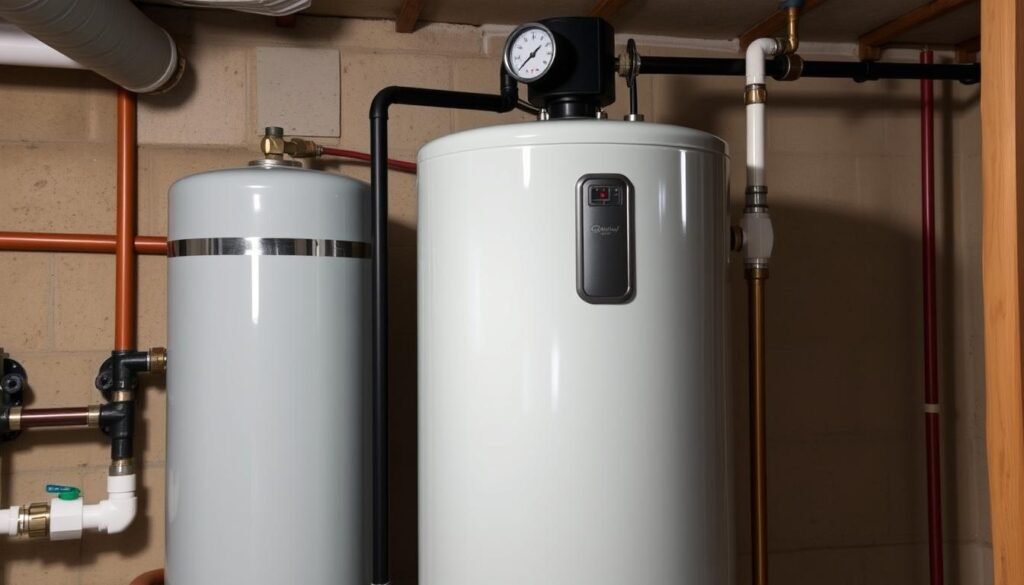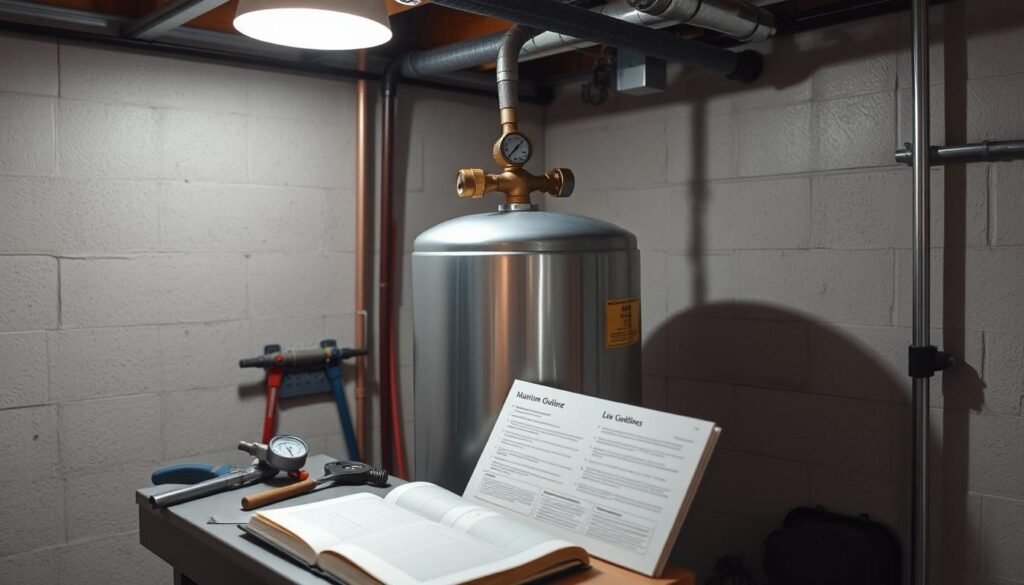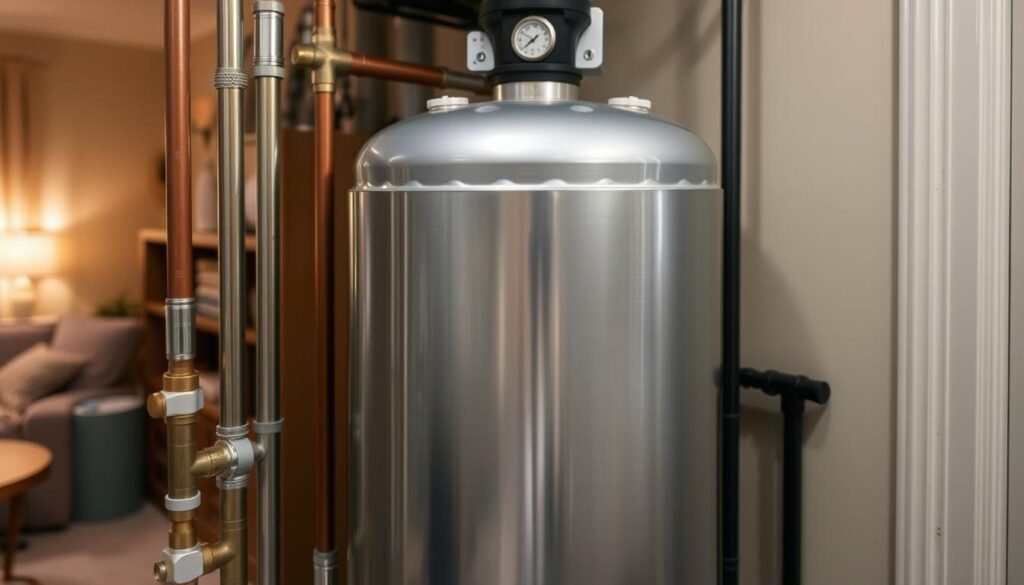A water pressure tank is vital for your home’s plumbing. It controls water pressure and flow, acting as a powerhouse. This tank protects pipes and fixtures by handling excess pressure in closed systems.
The tank creates a buffer for water expansion. This helps maintain steady pressure throughout your home. As a result, it boosts the efficiency of your entire plumbing system.
Table of Contents
ToggleKey Takeaways
- Water pressure tanks are essential components of a home’s plumbing system, regulating water pressure and flow.
- They protect against pipe and fixture damage by accepting excess water pressure in a closed plumbing system.
- Water pressure tanks help maintain consistent water pressure throughout the home, improving overall plumbing efficiency and performance.
- These tanks act as a buffer for water expansion, ensuring the stability of the plumbing system.
- Proper maintenance and inspection of water pressure tanks are crucial for optimal performance and longevity.
The Importance of Expansion Tanks
Closed plumbing systems need expansion tanks. These small tanks allow water to expand safely. They prevent pressure buildup that can cause various problems.
Understanding Closed Plumbing Systems
Closed systems often have pressure reducing valves, backflow preventers, or hot water recirculating pumps. These components require an expansion tank to maintain system integrity.
Common Indicators of a Closed System
- Pressure reducing valve
- Backflow preventer
- Hot water recirculating pump
Expansion tanks manage thermal expansion in closed systems. They protect pipes, fixtures, and water heaters from excessive pressure. This simple component ensures your plumbing system’s health and safety.
| Component | Lifespan |
|---|---|
| Expansion Tank | 6 to 10 years with proper maintenance |
| Pressure Tank | 5 to 7 years with little to no maintenance required |
Expansion tanks generally last longer than pressure tanks. They’re a crucial investment for your home’s plumbing stability.
“In 2007 and 2008, videos of water heater explosions went viral, sparking concerns about the safety of home water heaters.”
Knowing about expansion tanks helps homeowners protect their homes. It ensures reliable performance of their water system.
Water Pressure Tank: A Safety Device
The water pressure tank is vital for your home’s plumbing system. It protects your water heater from damage caused by high pressure. As water heats, it expands, and the tank absorbs this excess pressure.
This buffer prevents harm to your water heater and other plumbing parts. Without it, the closed system would have nowhere for expanded water to go.
Protecting Your Water Heater
When water heats up, it expands and builds pressure. A working pressure tank absorbs this extra force. This keeps your water heater safe from strain and early failure.
Proper tank sizing and installation are key. Consider your system’s flow rate and the tank’s preset pressure range. A well-designed tank can extend your water heater’s life.
Understanding the pressure tank’s role helps homeowners protect their plumbing. Regular checks and upkeep of the tank are crucial. These steps safeguard your home’s entire plumbing system.
Consequences of Excessive Water Pressure
A faulty water pressure tank can cause serious problems. High water pressure can damage pipes and fixtures. This can lead to expensive repairs in your home.
Water Hammer and Noisy Pipes
Excessive water pressure often causes “water hammer.” This happens when water flow stops suddenly. Pipes shake and make loud banging noises.
Over time, water hammer can damage pipes. This may result in leaks and other plumbing issues.
Leaky Pipes and Fixtures
High water pressure can cause leaks in pipes and fixtures. It puts extra stress on the plumbing system. This leads to early wear and tear.
Cracks and holes may form, allowing water to escape. These leaks waste water and can damage your home. Repairs for water damage can be costly.
| Issue | Consequence |
|---|---|
| Water Hammer | Pipe damage, leaks, and other plumbing failures |
| Leaky Pipes and Fixtures | Water waste, water damage, and costly repairs |
| Excessive Water Pressure | Premature wear and tear on plumbing system components |
Knowing these risks can help homeowners protect their plumbing. Taking action early can prevent costly repairs later on.
The Role of Water Pressure Tanks in Arizona
Arizona’s hot climate makes water pressure tanks crucial. Extreme temperatures can cause water expansion in plumbing systems. This puts extra stress on the entire system.
Extreme Heat and Water Expansion
Without a good water pressure tank, Arizona homes may face plumbing problems. These include water hammer, leaky pipes, and early water heater failure. Extreme heat can cause too much pressure in closed plumbing systems.
About 45% of rural Arizona homes use well water systems. These systems rely heavily on water pressure tanks. Homes with these tanks see 30% less pump cycling, leading to longer pump life.
Well pumps with water pressure tanks use 20% less electricity. This saves money for Arizona homeowners. Regular maintenance can extend tank life by up to 10 years.
Homes with water pressure tanks have backup water during power outages. This shows how useful these systems are in emergencies. In Arizona’s extreme heat, these tanks are vital for maintaining water pressure.
Signs You Need a Water Pressure Tank
Your home’s plumbing system relies on a water pressure tank. It regulates water pressure and ensures consistent flow. Over time, these tanks may need replacement or maintenance.
Here are some issues that suggest it’s time to upgrade your water pressure tank:
- Knocking Pipes: Banging or knocking sounds in your plumbing system often indicate excessive water pressure, which can be caused by a faulty or inadequate water pressure tank.
- Dripping Faucets: Persistent leaks from your faucets may be a sign that your water pressure tank is not properly maintaining the system’s pressure, leading to increased wear and tear on your fixtures.
- Premature Water Heater Failure: If your water heater is experiencing premature wear and tear or shutting off unexpectedly, it could be due to fluctuations in water pressure caused by a malfunctioning water pressure tank.
The pressure inside the well tank should be 2 psi below its cut-on point. A waterlogged tank with a ruptured bladder can cause noticeable pressure changes throughout your home.
| Issue | Potential Cause | Average Repair Cost |
|---|---|---|
| Knocking Pipes | Faulty or inadequate water pressure tank | $120 – $175 |
| Dripping Faucets | Improper water pressure regulation | $120 – $175 |
| Premature Water Heater Failure | Fluctuations in water pressure | $120 – $175 |
If you notice these water pressure problems, seek professional help. A expert can assess your water pressure tank and suggest solutions. Early action can prevent costly future repairs.
“Over a decade old: Consider replacing the well pressure tank as it might be reaching the end of its lifespan.”
John’s Well Drilling offers expert well maintenance services. Our team has over 40 years of industry experience. We’re licensed for well drilling and geothermal system installation.
We’re accredited by the Better Business Bureau. Call us at 302-734-2211 for a free quote. We’ll ensure your water pressure tank works properly and your plumbing system performs optimally.
Choosing the Right Water Pressure Tank
The size of your water pressure tank is vital for consistent home water pressure. Your tank choice depends on water usage, plumbing system size, and appliances. A proper tank ensures optimal performance and protects your plumbing system.
Tank Size Considerations
Pressure tanks come in sizes from 20 to 120 gallons. The drawdown capacity varies based on tank size. This is the water volume drawn before the pump activates.
Here’s a quick breakdown of tank sizes and their drawdown capacities:
- 20-gallon tank = 6 gallons of drawdown
- 30-gallon tank = 9 gallons of drawdown
- 50-gallon tank = 14 gallons of drawdown
- 85-gallon tank = 25 gallons of drawdown
- 120-gallon tank = 36 gallons of drawdown
The pressure switch settings on the tank also affect drawdown capacity. These settings are typically 20/40, 30/50, or 40/60.
| Flow Rate | Minimum Runtime |
|---|---|
| 0-10 GPM | 1.0 GPM |
| 10-20 GPM | 1.5 GPM |
| 20+ GPM | 2.0 GPM |
Sizing a water pressure tank requires considering flow rate, pressure switch setting, and pump minimum runtime. These factors determine the needed drawdown for best performance.
Choosing the right tank ensures a reliable and efficient home water supply. For more details, check out this guide on sizing a well pressure.

Professional Water Pressure Tank Installation
Your home’s plumbing system relies heavily on the water pressure tank. Professional plumbers have the expertise to install it correctly. They can maximize its effectiveness and protect your home’s plumbing.
Well water pressure tank installation costs range from $500 to $1500. The price depends on tank size, materials, and needed accessories. Professional installation ensures proper sizing and integration.
About 78% of well water households need a professional-grade pressure tank. Installation requires around 12 different tools and supplies. Professional plumbers have the equipment to handle complex installations efficiently.
Studies show 88% of successful installations occur in well-ventilated areas. This improves tank efficiency and durability. Twice-yearly maintenance can reduce leak risks by 85%.
Professional installation safeguards your investment. Their expertise and attention to detail ensure optimal plumbing system function. Trust the pros for your water pressure tank installation needs.
| Item | Average Cost |
|---|---|
| Well Pressure Tank | $200 – $800 |
| Professional Installation | $100 – $300 |
| Total Cost | $700 |
“Proper installation of a water pressure tank is crucial to ensure it functions as intended and provides the necessary protection for your home’s plumbing system.”
Maintaining Your Water Pressure Tank
Your water pressure tank needs regular care for a healthy plumbing system. Proper maintenance prevents costly repairs and extends the tank’s life. Regular checks keep your system running smoothly.
Regular Inspections and Maintenance
Experts suggest yearly inspections of your water pressure tank. This includes checking air pressure, testing functionality, and fixing any issues. Timely maintenance helps catch problems early.
Check the tank’s air pressure and adjust it as needed. Look for leaks or damage that might signal bigger problems. Test the tank’s pressure maintenance and address any fluctuations.
Clean the tank to remove sediment or buildup. This helps keep its performance top-notch.
- Check the air pressure in the tank and adjust as needed to maintain the optimal level.
- Inspect the tank for any signs of leaks or damage, which can indicate larger issues in the system.
- Test the tank’s ability to maintain pressure and address any fluctuations or drops in pressure.
- Clean the tank to remove any sediment or buildup that could affect its performance.
Regular upkeep can spot issues like waterlogging or pressure imbalances. It can also reveal a compromised bladder. Quick action on these problems prevents serious damage.
| Maintenance Task | Frequency |
|---|---|
| Check air pressure | Annually |
| Inspect for leaks | Annually |
| Test tank functionality | Annually |
| Clean tank | Annually |
Proactive care ensures your plumbing system works at its best. It provides reliable and efficient water delivery to your home.

Water Pressure Tank: Your Home’s Plumbing Powerhouse
The water pressure tank is vital for your home’s plumbing system. It regulates water pressure and flow quietly and efficiently. This key component ensures your plumbing works well and provides consistent water pressure.
The tank acts as a buffer for water expansion. It protects the water heater and maintains steady pressure. When water heats up, it expands. The tank handles this expansion, preventing damage to plumbing parts.
This tank also keeps water pressure stable during high demand. It stores pressurized water and releases it as needed. This ensures steady flow throughout your home.
Areas with unreliable water supply benefit greatly from pressure tanks. They help maintain consistent pressure even when municipal supply fluctuates.
Proper installation and upkeep are crucial for your plumbing system’s health. Regular checks can spot and fix issues early. This keeps the tank working well and providing optimal pressure.
Understanding your pressure tank’s role helps you maintain it better. You can ensure it continues to regulate pressure and flow efficiently. It will keep protecting your water-powered appliances and fixtures silently.
Instant Plumbing and Rooter: Experts in Plumbing Solutions
Instant Plumbing and Rooter is a family-owned plumbing company serving the Phoenix area since 2001. Their skilled technicians provide reliable solutions for various plumbing needs. They specialize in water pressure tank installations, maintenance, and repairs.
The company aims to keep Arizona homes’ plumbing systems running smoothly. Their expertise ensures efficient and problem-free operations for homeowners.
Family-Owned and Operated Business
Instant Plumbing and Rooter’s family-owned model has built a strong reputation over two decades. Their experienced Arizona plumbers deliver exceptional results with high standards.
The company focuses on personalized attention and tailored solutions for each client. This approach has earned them trust across the region.
Their technicians work hard to address unique needs in every job. They provide long-lasting results for water pressure tank installations, repairs, and maintenance.
| Service | Description |
|---|---|
| Water Pressure Tank Installation | Instant Plumbing and Rooter specializes in the installation and maintenance of water pressure tanks, ensuring your plumbing system operates at optimal efficiency. |
| Plumbing Repairs | The company’s skilled technicians are experts in addressing a wide range of plumbing issues, from leaky pipes and clogged drains to malfunctioning water heaters. |
| Routine Maintenance | Instant Plumbing and Rooter offers comprehensive plumbing maintenance services to keep your home’s plumbing system running smoothly and prevent future problems. |
Instant Plumbing and Rooter is a trusted name for Arizona homeowners. They offer exceptional service and reliable plumbing solutions.
Need a water pressure tank installation or other plumbing service? The Instant Plumbing and Rooter team is ready to help.
Conclusion
The water pressure tank is crucial for your home’s plumbing system. It regulates water pressure and flow efficiently. Understanding its importance helps homeowners maintain their plumbing system’s health and efficiency.
Regular maintenance and professional installation are vital for a water pressure tank. These steps maximize its benefits and prevent costly plumbing issues. With proper care, the tank becomes a reliable part of your home’s plumbing system.
A well-maintained tank ensures consistent water pressure throughout your home. It also improves energy efficiency and extends your water pump’s lifespan. This plumbing powerhouse truly deserves your attention and care.
Prioritizing tank maintenance leads to a well-functioning home plumbing system. It ensures proper water pressure regulation for years to come. This gives homeowners peace of mind about their plumbing system’s performance.
FAQ
What is a water pressure tank?
A water pressure tank regulates water flow in home plumbing systems. It acts as a powerhouse, accepting excess pressure in closed systems. This tank protects pipes and fixtures from damage.
Why are expansion tanks important in a closed plumbing system?
Expansion tanks are vital in closed plumbing systems. They provide space for water to expand, preventing pressure buildup. This small tank helps avoid various plumbing issues.
How does the water pressure tank protect the water heater?
The water pressure tank safeguards the water heater from excessive pressure. As water heats and expands, the tank absorbs the excess pressure. This prevents damage to the heater and other plumbing parts.
What are the consequences of excessive water pressure in a plumbing system?
Excessive water pressure can cause water hammer, creating loud banging noises in pipes. It may lead to leaky pipes and fixtures. The added stress can cause premature failures and costly repairs.
Why is the water pressure tank crucial in the hot and sunny climate of Arizona?
Arizona’s extreme temperatures increase water expansion in closed plumbing systems. This puts more stress on the system. Without a proper tank, homeowners risk plumbing problems and premature water heater failure.
What are the signs that indicate the need for a water pressure tank?
Knocking pipes, dripping faucets, and early water heater failure indicate the need for a tank. These symptoms often result from excessive pressure in closed systems. Installing a proper tank can solve these issues.
What factors should be considered when selecting a water pressure tank?
Consider the tank’s size and capacity when selecting one. Choose based on home water usage and plumbing system size. Factor in additional water-using appliances for optimal performance and protection.
Should homeowners install a water pressure tank themselves?
It’s best to have a licensed plumber install your water pressure tank. Proper installation ensures correct integration into the plumbing system. Professional plumbers can assess your system and select the right tank size.
How can homeowners maintain their water pressure tank?
Regular inspections and maintenance are crucial for water pressure tanks. Check air pressure and test the tank’s functionality often. Address issues promptly to prevent costly repairs and extend your plumbing system’s lifespan.

